5.1 Collaborative Writing
What is Collaborative Writing?
Collaborative writing, group writing, team writing, and distributed writing are all terms used interchangeably to describe what it means to perform collective writing in a professional atmosphere. For our purposes, however, we will refer to the act of writing together as collaborative writing. Collaborative writing entails the collective efforts of a group of people who work together on a written project. The main goal of collaborative writing is to produce the best work for the good of the company or organization by including the ideas and skill sets of multiple writers.
Collaboration involves a mindset that sees the whole as more important than its parts. In other words, when people decide to collaborate, they are deciding to set aside their individual goals for the good of the group or company they represent. Collaboration seeks to combine multiple skill sets, knowledge bases, ideas and engagement from a number of people for the sole purpose of accomplishing a goal that benefits all, regardless of position or title. A collaborative mindset is focused on company success more than individual success.
According to Ron Ricci and Carl Wiese, authors of the book The Collaboration Imperative (2011), a company’s success lies within the people they employ. “It’s not hiding in a budget spreadsheet or a warehouse full of inventory. It lies within your people—in their ideas, their experiences, their focus, their energy. The more you empower them to share their knowledge and skills, the more successful your organization will be. From ideas come innovation and new forms of productivity.”
In their 2015 book Collaboration Begins with You: Be a Silo Buster, best-selling author and management expert Ken Blanchard, along with co-authors Jane Ripley and Eunice Parisi-Carew, define collaboration as “… a whole order of magnitude beyond teams. It’s in the DNA of the company culture.” They write, “It’s an environment that promotes communication, learning, maximum contribution, and innovation—which, of course, all lead to healthy profits.”
Thus, successful collaborative writing stems from a company culture that invites collaboration not just writing by way of teams and groups.
Collaborative writing is writing that entails the collaborative efforts of a group of people who gather together to write documentation, produce images, provide subtext, and more in an effort to bring a project to completion. Members can work in spaces that are face-to-face or virtual. The main goal of collaborative writing is to produce the best work for the good of the company by including the ideas and skill sets of multiple authors.

Why Write Collaboratively?
In today’s ever-changing, fast paced world of information, technology and social media, it is increasingly necessary to engage people who are able to contribute a varied set of skills, specialties and who come from various cultures in an effort to produce information that best reflects the company it represents. Today, people in government, science and technology are called upon on a regular basis to communicate large bodies of information in the best and most cost-efficient way possible with an outcome that allows a broad range of people from various backgrounds and walks of life to not only access the information, but to understand the information set forth. Thus, collaborative groups of writers have become more important than ever, making information even more accessible to multiple groups of people.
But collaborative writing is not something that happens in a vacuum, nor is it magically produced after a brief period of writing. Collaborative writing, like all other types of writing, is something that requires engaging in the writing process. And while it is also something that requires time and labor, the results can be rewarding. Companies all over the world have found that writing collaboratively can produce favorable outcomes for their better interests. This, however, does not come without costs. While there are many benefits to collaborative writing, there are also disadvantages if the project morphs into team or group writing.
Benefits of Writing Collaboratively
Collaborative writing has many benefits. Because many companies believe the advantages of collaborative writing outweigh the disadvantages, many companies choose to have employees work together on projects with writers as a part of those teams.
Let’s look at some of the advantages of collaborative writing:
-
-
- Collaborative writing creates a more enjoyable work environment. Because members of the team share the responsibilities of the project or writing, they must communicate verbally, electronically, and in some instances they must communicate virtually. These interactions often work to improve and foster a collegial atmosphere, producing a workplace that adds to the overall good of the company.
-
-
-
- Collaborative writing creates a product that considers diverse audiences. When a team is created with the thought of diversity, the work they produce tends to be more sensitive to varied cultures and audiences. If, for example, the team incorporates the skill sets of women, men, members of the LGBTQ+ community, cis and non-cis males and females, non-binary persons, as well as members of various races and cultures, the final product will have taken into consideration the complexities of multiple communities, something that is not so easily attained by a single community of writers.
-
-
-
- Collaborative writing provides an opportunity for employees – both new and not-so-new – to explore skills as both leaders and subordinate team members. A sage once said, “To be a good leader, you must learn to follow.” Now and then a true leader is born, but a really successful leader is one who has learned to follow. Employees who have been groomed and allowed to rise through the ranks often make the most successful leaders because they are able to understand the tasks at hand and empathize with the challenges created as a result of the task. Likewise, when organizations choose to rotate the roles of team members, it allows employees to participate in roles such as team lead, recorder, researcher, editor, reporter, and more.
-
-
-
- Collaborative writing fosters engagement through active learning. When employees write collaboratively, they put themselves in a position to either learn from or hone their dormant skills as they work with colleagues who may be more adept at a certain skill than they are.
-
-
-
- Collaborative writing helps to grow the organization. When all of the members of the team see their contribution as not just important but imperative to the success of the project, they contribute as an owner rather than a worker, ultimately affecting the bottom line – profit. And when a company has become successful as a result of fully engaged employees who see their contributions as the reasons behind the company’s success, the longevity of the company is inevitable.
-
-
-
- Collaborative writing produces a superior product or outcome. When performed correctly (see notes above about what true collaborative writing is and is not), the end result of the project will be more superior to anything produced outside of collaboration because the most advanced skills will have been utilized and because the members of the team will have drawn on their commitment to the end result for the good of not just themselves but for the good of the entire company.
-
-
-
- Collaborative writing draws on the use of technology. With the emergence of so many new collaboration tools and other technological advances designed to make writing more efficient, employees are better able to engage with their colleagues and produce projects in less time and with fewer obstacles than they could without those tools. There are various types of collaboration tools, including email, voicemail, instant messaging (IM), VoiP video call (or voice over IP), online calendars, wikis, and, as mention on the previous page, shared document workspaces, such as Google Docs.
-
Collaborative Writing Stages
Successful collaborative writing is made easier when you understand the different strategies you can apply, how best to control the document, and the different roles people can assume. Figure 5.1.2 outlines the activities involved at various stages of the collaborative writing process.

Image description of Figure 5.1.2—the four collaborative writing stages:
-
-
-
-
- Team Formation
- Team introductions; getting to know each others’ skill sets
- Team bonding; building trust
- Operating agreements; setting expectations
- Team Planning
- Review tasks to be done and roles of each teammate; create work plan
- Set team goals and objectives: milestones, deliverables, due dates
- Determine processes for workflow and decision making
- Document Production
- Plan the document: research, brainstorm, outline the document format and content
- Compose a draft of the document
- Revise: iterative revisions, consider using an outside peer reviewer
- Wind Up
- Final document review to edit and approve content, organization, and style
- Final document processing (proofreading and submitting)
- External approval
- Team Formation
-
-
-
Collaborative Writing Roles
Roles in a collaborative project refer to the different responsibilities that participants have, depending on the activity. Table 5.1 below describes several roles within a collaborative writing team. After reviewing these various roles, take a moment to reflect on which role(s) you have held in a group project. Are there roles, such as team leader or writer, that you always seem to do? Are there roles that you prefer, ones that you dislike, or others that you would like to try?
TABLE 5.1 – Collaborative Writing Roles
| Role | Description |
|---|---|
| Writer | A person who is responsible for writing a portion of the content |
| Consultant | A person who is external to the project and has no ownership or responsibility for producing content but who offers content and process-related feedback (peer reviewers outside the team; instructor) |
| Editor | A person who is responsible for the overall content production of the writers, and can make both style and content changes; typically has ownership of the content production |
| Reviewer | A person, internal or external, who provides specific content feedback but is not responsible for making changes |
| Team Leader | A person who is part of the team and may fully participate in authoring and reviewing the content, but who also leads the team through the processes, planning, rewarding, and motivating |
| Facilitator | A person external to the team who leads the team through processes but doesn’t give content related feedback |
Review the various roles above and complete the following short activity to test your knowledge:
Chapter 5 Assignment: Team Project
Additional Resources
- “Collaborative and Group Writing,” an article from Univ. of Wisconsin Writing Center
- “The Collaboration Imperative: Executive Strategies for Unlocking Your Organization’s True Potential,” a guide from the company Cisco Systems on the benefits of collaborative writing
CHAPTER ATTRIBUTION"Collaborative Writing." Open Technical Communication. [License: CC BY-SA 4.0] "4.3 Collaborative Writing," Technical Writing Essentials. [License: CC BY-SA 4.0] Figure 5.1.1, "Women at the Meeting." RF.Studio Pexels.com. Photograph. 25 Feb, 2020 Figure 5.1.2, "Collaborative Writing Stages." Suzan Last. [License: CC BY 4.0] |

